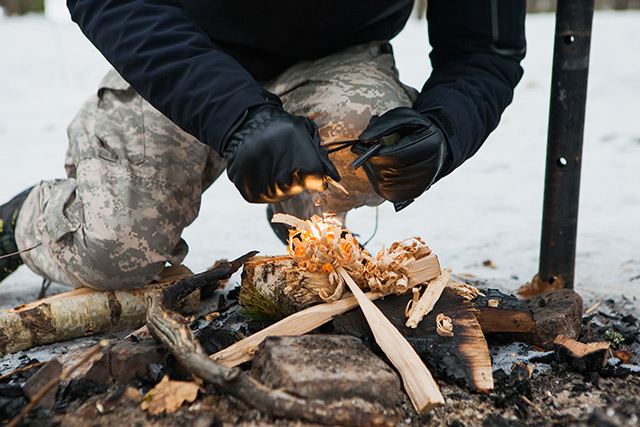For the survivalist prepper: How to build a fire AND remain hidden in the wild
07/13/2018 / By Rhonda Johansson

Fire: The stolen gift of the gods given to humanity by the titan, Prometheus, that damned him to an eternity of torment. Without fire, society would never flourish and progress would never occur. This survival staple is also without comparison – and any prepper knows that after water and shelter, the most important thing to have is burning flames.
Fire serves several purposes in survival. It cooks your food, keeps you warm, and scares off predators. Nevertheless, the resulting smoke from most basic fire pits can let other people know where you are.
There may be moments when you need to conceal yourself or preserve fuel for a more efficient fire. For these cases, you will need to know how to create a smokeless survival fire.
In order to have a smokeless fire, you would need to keep the fire burning properly. Smoke is a natural byproduct of an incomplete combustion. We have listed three methods that even beginner preppers can use to conceal their fires. (h/t to ThePreppingGuide.com.)
- The “upside down” fire – As the name suggests, this is where you design your fire pit in the opposite manner. This means arranging your main fuel first then building your fire on top of it. You would need a lot of fine tinder and kindling to make this type of fire; but, done successfully, the fire will burn off the smoke as it passes through the flames.
- The teepee – This is a popular approach used by many preppers. The teepee method is a great way to start a fire and is one of the more recommended options if you need to quickly boil your water or food. While not exactly smokeless, the teepee burns quickly so its remnants are very easy to hide.
- Dakota fire hole – Any prepper worth their salt knows this fire lay. It is regularly taught in military survival schools but is generally known by most preppers. It is simple to construct and does not cast too much light or smoke.
Making a Dakota fire hole
This type of fire lay is relatively straightforward and can be done with limited tools. First, dig a pit in the ground with a sharpened stick. Dig two holes about a foot apart and then carefully tunnel between them. One pit should be slightly larger; two feet deep and spacious enough to fit a decent fire. The other pit does not have to be quite as big but large enough to supply ample air to your fire. As the fire burns, air will be sucked into the other hole you have made and keep the fire burning hot.
Sponsored solution from the Health Ranger Store: Lab-verified Nascent Iodine solution is a dietary supplement that provides your body with supplemental iodine to help protect your thyroid during radiation exposure. Nuclear accidents such as Fukushima (or nuclear war) can expose your body to radioactive iodine-131, a dangerous radioisotope. Pre-loading your system with stable iodine occupies the iodine receptor sites on your organs, causing your body to naturally expel radioactive iodine you may have been exposed to through air, food, water or milk products. This defensive strategy is recommended by nearly all health authorities, worldwide, including the Nuclear Regulatory Commission. Discover more at this link.
What makes the Dakota fire hole the best option for creating a smokeless fire is that you can easily cover up the traces by burying the hole with dirt or sand. DO NOT use water, as this will create unnecessary smoke. An underground fire lay is also a great tactical option, especially at night. (Related: Conceal your raging campfire with the ancient Dakota fire hole technique.)
After you have dug the holes, start shaping your kindling in the larger pit, but make sure you do not overload it. You will still need some room to work with. Gather the tinder and light it with your matches or whatever method you choose in lighting a fire. Once the kindling is burning, you will need to constantly maintain the fire so make sure you have a good supply of fuel and gradually add this to the pit as necessary.
General fire knowledge
Before you actually make a fire pit, you first have to learn how to light a fire. The easiest way to start a fire is with a match. If you find yourself lost in the wilderness, however, with nary a tool on you, the most reliable method is to use flint and steel (fire steel). Fire steels produce hot sparks that can ignite fine tinders. It does take quite a lot of trials (especially if you’ve never lit a fire using this method before) but eventually, a spark will ignite.
The best way to learn all of this is through practice. Even if TEOTWAWKI hasn’t happened yet (and hopefully never will), the smart prepper anticipates the unexpected and starts trial runs every now and then.
You can do the same and read more helpful guides like this at Survival.news.
Sources include:
Tagged Under: camping, Dakota fire hole, fire, fire knowledge, fire lays, fire pits, Gear, how to build a fire, off grid, prepping, SHTF, survival, TEOTWAWKI




















